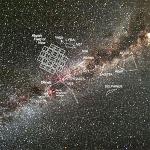26 October 2010

Photo: C. Roberts - NASA
Kepler's field of view superimposed on the night sky
For thousands of years, humans have gazed up at the night sky and watched the stars. Now, NASA's Kepler mission gives scientists the chance to listen to the stars.? Astronomers are using stellar soundwaves to measure stars more accurately than ever before.
It might not sound like much.
... but you just heard a star. Actually, a few vibrating red giant stars.
"A Kepler red giant concert, so to say," said Daniel Huber.
Daniel Huber is a doctoral student at the University of Sydney in Australia. He is a member of an international team of astronomers that is using data from NASA's Kepler spacecraft to study stars and their structures.
Kepler uses a huge digital camera to continuously monitor the brightness of more than 150,000 stars as it orbits the sun.
Huber is among the scientists who study red giant stars, which are nearing the ends of their lives.
Scientists say the stars get older, temperatures near their cores rise and their sizes expand.
"Every red giant that we've detected oscillations in has its unique sound, its unique amplitude and frequency, and we can therefore say that Kepler is basically listening to thousands of "musicians" in the sky," he said.
It comes down to asteroseismology, which is the study of star oscillations. So-called "starquakes" show up as periodic variations in the brightness of the stars. They help asteroseismologists learn about the inner structure of stars in the same way that seismologists use earthquakes to learn about inner Earth.
Travis Metcalfe, a scientist at the National Center for Atmospheric Research in Colorado, says seismology is like taking an ultrasound image. But, he says, the stars generate their own soundwaves from the boiling motions near the surface. Metcalfe explains that soundwaves travel down into the star and bring information back to the surface, which NASA's Kepler spacecraft records as a flickering in the brightness of the star.
"To measure the size of a star, we essentially measure the tone of these musical notes from the starlight," said Travis Metcalfe. "Just as it's easy to hear the difference between a note played on a cello and a violin, larger stars naturally flicker in lower tones, while smaller stars flicker in higher tones."??
So, bigger stars sound lower, like a cello, while a smaller star's tone is more like that of a correspondingly smaller violin.
Scientists analyze a star's soundwaves to learn the size, shape and age of that star, and that information helps them understand the way the relationship between stars and their planets evolve.
The tones of stars' soundwaves are so low that even whales would have a hard time hearing them, but Huber says scientists scaled them to the audible range of the human ear. Once again, here are the sounds of several stars, based on actual frequencies measured by Kepler.
Scientists representing the Kepler Asteroseismic Science Consortium presented these stellar sounds and findings during a teleconference Tuesday from Aarhus University in Denmark.
Astronomers who use Kepler data say the mission helps them understand what will become of our Sun in about 5 billion years, and it helps them identify planet-hosting stars as astronomers search for Earth-like planets.
The Kepler spacecraft was launched in March of 2009. NASA praises the mission as an example of international partnership, saying the U.S. space agency provides the spacecraft and data, while hundreds of scientists around the world analyze the findings.